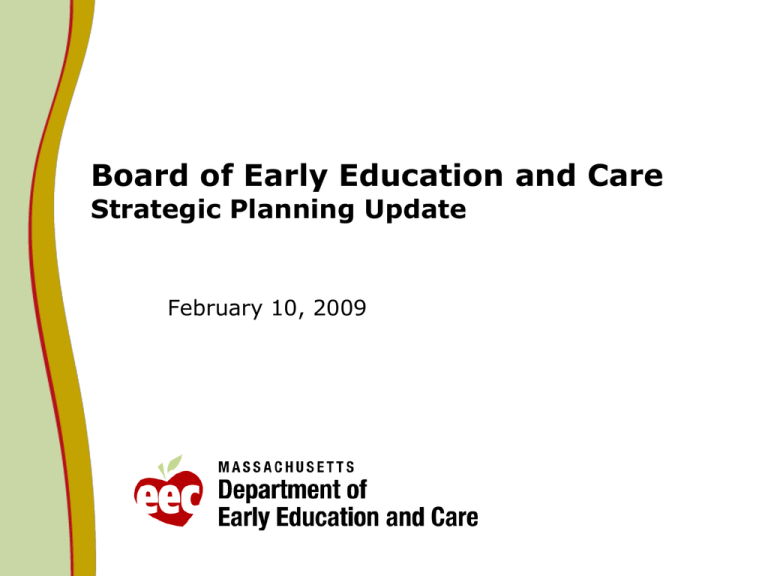Board of Early Education and Care Strategic Planning Update February 10, 2009
advertisement

Board of Early Education and Care Strategic Planning Update February 10, 2009 Strategic Planning Process Formed planning sub-committee in February to develop plan Used inclusive process that involved many stakeholders: Parent Advisory Team Advisory Team EEC Staff Steering Committee Board held series of retreats over the summer to take stakeholder input and develop strategic framework Board held retreat in October to finalize the strategic framework 2 Purpose of the Strategic Planning Process To develop a strategic framework for Board and agency priorities to aid decision making and strengthen accountability Also mandated by statute to develop 5-year strategic plan 3 Results of the Strategic Planning Process The EEC Strategic Plan: Lays out aspirations and expectations for ourselves Compels us to engage the larger public more in our work Challenges us to be accountable for successes and failures Gives strategic directions and tangible indicators of progress 4 Overview of Strategic Plan MISSION VISION STRATEGIC DIRECTION 1 STRATEGIC DIRECTION 2 STRATEGIC DIRECTION 3 STRATEGIC DIRECTION 4 STRATEGIC DIRECTION 5 SUCCESS SUCCESS SUCCESS SUCCESS SUCCESS INDICATORS INDICATORS INDICATORS INDICATORS INDICATORS ___________ ___________ ___________ ___________ ___________ EEC will develop an accompanying “WORK OF SUCCESS” plan outlining key tasks and action items for implementing the Strategic Plan. It will include three and one year accountability goals for each Strategic Direction. 5 The Mission The Massachusetts Department of Early Education and Care provides the rich foundation that supports all children in their development as lifelong learners and contributing members of the community, and supports families in their essential work as parents and caregivers. 6 The Vision Practical Five-Year Vision EEC and the whole field of early education and care are highly regarded, publicly recognized and supported, and clearly understood to be a value to the Commonwealth. EEC’s system offers an array of high quality, comprehensive and affordable programs designed to meet the diverse, individual needs of children & families. The early education and care workforce is respected, diverse, professional, qualified, and fairly compensated. EEC is an effective, responsive, efficient, and resilient system. EEC has clear standards for accountability and evidence that those standards are being met. Families are engaged as partners integral to the healthy development and learning of their children, and they have access to the necessary resources to do so. All preschool children have access to high quality pre- kindergarten programs that meet family needs. Children and families experience seamless transitions throughout their early learning and later developmental experiences. 7 Strategic Directions 1. Quality: Create and implement a system to improve and support quality statewide 2. Family Support, Access, and Affordability: Increase and promote family support, access and affordability 3. Workforce: Create a workforce system that maintains worker diversity and provides resources, supports, expectations, and core competencies that lead to the outcomes we want for children 4. Communications: Create and implement an external and internal communications strategy that advocates for and conveys the value of early education and care to all stakeholders and the general public 5. Infrastructure: Build the internal infrastructure to support achieving the vision 8 EEC Strategic Framework Mission The Massachusetts Department of Early Education and Care (EEC) provides the foundation that supports all children in their development as lifelong learners and contributing members of the comm unity, and supports families in their essential work as parents and caregivers. Practical Five-Year Vision EEC and the whole field of early education and care are highly regarded, publicly recognized and supported, and clearly understood to be a value to the Commonwealth. Th ree Year Strategic Directions o Create and imp lement a system to improve and support quality statewide. EEC’s system offers an array of high quality, comp rehensive and affordable programs designed to me et the diverse, individual needs of children & families. o Increase and promote family support, access and affordability. The early education and care workforce is respected, diverse, professional, qualified, and fairly compensated. o Create a workforce system that maintains worker diversity and provides resources, supports, expectations, and core comp etencies that lead to the outcome s we want for children. o Create and imp lement an external and internal communications strategy that advocates for and conveys the value of early education and care to all stakeholders and the general public. o Build the internal infrastructure to support achieving the vision. EEC is an effective, responsive, efficient, and resilient system. EEC has clear standards for accountability and evidence that those standards are being met. Fami lies are engaged as partners integral to the healthy development and learning of their children, and they have access to the necessary resources to do so. All preschool children have access to high quality pre- kin dergarten programs that meet family needs. Children and families experience seaml ess transitions throughout their early learning and later developmental experiences. 9 Next Steps Board votes on and releases Strategic Plan. EEC completes “Work of Success”/ Work Plan that outlines 3-5 year actions items and initiatives required to make progress towards the Indicators of Success and Strategic Directions. Board and EEC identify overarching data indicators to measure progress over time in achieving the Vision. Align with Governor’s MassGoals initiative. Update and adjust plan annually, particularly the Work of Success and annual accountability goals. 10
